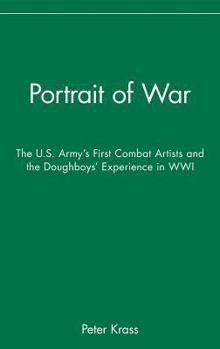Portrait of War: The U.S. Army's First Combat Artists and the Doughboys' Experience in Wwi
Select Format
Select Condition 
Book Overview
Portrait of War tells the gripping true story of eight graphic artists recruited by the government and sent into combat to create a visual historical record of World War I. Featuring both their... This description may be from another edition of this product.
Format:Hardcover
Language:English
ISBN:0471670235
ISBN13:9780471670230
Release Date:October 2006
Publisher:Wiley
Length:352 Pages
Weight:1.45 lbs.
Dimensions:1.1" x 6.4" x 9.4"
Customer Reviews
3 ratings
Portrait of War
Published by Thriftbooks.com User , 16 years ago
What a surprise. Peter Krass does a brilliant and engaging job capturing the details of the the Official War Artist's experiences as they chase the American Doughboys across France throughout their entire engagement in WWI. For anyone interested in either the war or the role of art in interpreting war. Importantly it captures the details of Harvey Dunn's role, one of America's leading and most influential illustrators. I highly recommend this book. It is a unique and fresh insight into these subjects. My highest recommendation.
Refreshing Look at WWI
Published by Thriftbooks.com User , 17 years ago
PORTRAIT OF WAR reads like a novel - it was a pleasure. There are great characters, drama, an honest portrayal of war. And while the art of the combat artists is discussed somewhat, the balance is perfect by not overindulging in art theory, etc. Too many history books are not accessible to the average reader - they're too long or too dense - but not this one. I even gave it to my young teenager to read and he's thoroughly enjoying it.
Spectacle of Spectacles
Published by Thriftbooks.com User , 17 years ago
Although the so-called "Great War" ended nearly ninety years ago, there are still new stories to be told, and Peter Krass, author of a fine biography of Andrew Carnegie, has written one of them. Plus he was lucky enough to secure the cooperation of one of his subject's sons, George Harding Junior, who opened his father's archive to apparently unrestricted use, a true coup for a biographer. Not that this is a biography in any real sense, for the action takes place during an intense period of two years, and an epilogue briefly charts the postwar lives of his eight subjects, a paragraph apiece. Amazingly none of them were killed in the War. What a difference from the British and French artists who these American men were imitating! As Krass tells it, all one hundred of the British "official artists" were mowed down in the slaughterhouse that was Europe. Perhaps inevitably. the lives of these men after the war don't seem very interesting after the thrills and the horrors they experienced, but one or two of them left hints of interesting careers that I hope get explored in later volumes. Harding himself, if you can imagine, volunteered again in the SECOND World War, becoming the only artist brave enough, or crazy enough, to sign on in both wars. J. Andre Smith became a "pioneer of surrealism," whatever that means, and suffered from phantom pain all his life after his right leg was amputated above the knee. (Harding and Smith managed to live all the way through to 1959, though none of the artists made it to the 1960s.) Ernest Peixotto became a famous muralist and art activist, particularly in New York during the Depression and the WPA years, serving under Fiorello LaGuardia. The rest of them had OK careers. The day to day adventures of these 8 captains are remarkably well documented in a steady stream of letters home, personal diaries, after-the-war memoirs, and beyond these, the art works themselves created by these men, a body of work comprising over 500 different pieces (now owned by the Smithsonian). From Chateau-Thierry and Belleau Wood, they went scouting for materials on which to build propaganda. That was their mission pure and simple. The AEF hired them for one reason alone, to bring the war home, or perhaps to dissolve the boundaries between war and home so that more recruits would come to replace the bodies of their fallen comrades. Harry Townsend despaired of war, as he viewed the bodies at Chateau Thierry--too many to bury, heaped up like sardines, thousands and thousands of men. Rumors spread that the powers that be intended to leave them there until all were nothing but bones, for cleanup would be easier that way. "What a thought," Townsend added with disgust. A Christian Scientist by nature, he believed that healing and prayer would shield him from the worst, but when the shells came rattling down on his tin roof, he couldn't even sleep. The book is packed with marvelous scenes: Peixotto and Morgan passing through ru




